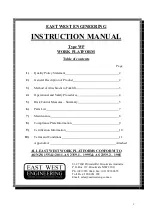
2-10
F-581-R1
PLANNED MAINTENANCE
Drive Wheel Lug Nuts
Re-torque the drive wheel lug nuts to 225ft-lbs (300Nm)
once during the first 50 to 100 hours of operation, then
once every 300 hours thereafter.
Hydraulic System Maintenance
Maintain the hydraulic system, and associated
components, as required by the various inspection
checklists.
CAUTION
Cylinders and Valves:
Check these components for drift and leakage. Refer to
Landoll Corporation and other vendor service information
for specifications.
Hoses and Tube Lines:
Check for cracks, hardening, or other signs of wear.
Reroute any usable hoses that are kinked, severely bent,
or rest against hot parts. Look for leaks, especially at
couplings and fittings. Replace any hoses or tube lines
that do not meet system flow and pressure ratings.
Hydraulic Fluid:
Check fluid level and look for air bubbles.
Check the filter.
Check the hydraulic oil level when the oil is at operating
temperature, the carriage is lowered and the engine is
stopped. Add hydraulic oil only as needed. If more
hydraulic oil is added over the “FULL” level, the hydraulic
oil will leak from the breather during operation. The
oil level indicated by the sight gauge is most accurate
when the oil temperature is 130º to 200º F (53º to 93º C).
See page 1-17 for recommended lubricants.
Other Hydraulic System Components:
Visually check other components to see if they are
loosely mounted, show signs of leaks, damage or wear.
Side Shift Circuit Maintenance
DANGER
To check side shift circuit performance:
1.
Side shift completely to the left and hold the control
handle in this position for 5 seconds.
2.
Check for external leaks at the cylinder, fittings, and
hoses.
3.
Side shift completely to the right and hold the control
handle in this position for 5 seconds. Check for
external leaks at the cylinder, fittings, and hoses.
Identification Plate and Safety
Warnings
DANGER
Contact Landoll Corporation if any accessories that
modify the capacity and forklift
operation are planned.
After the factory reviews your request, new identification
tags will
be issued to update the rated capacity and other
operation characteristics.
•
DO NOT allow hydraulic fluid level to drop
significantly or allow the
reservoir to run dry.
This will induce air into the system and cause
damage to hydraulic system components.
• Prevent dirt or other foreign matter from
entering the hydraulic system; clean filler
caps before checking oil level.
•
Before you remove any hoses or tubes,
relieve hydraulic system
pressure. With the
forklift “OFF”, open the forklift auxiliary
control valve(s) several times in both
directions.
• Check for hydraulic fluid leaks using a piece
of cardboard or wood. DO NOT use your bare
hands.
• Remember to wear safety glasses.
• Hydraulic oil can be under very high
pressure. A pinhole leak is not easily seen
and if it pierces your skin, can possibly cause
death. Seek medical attention immediately.
Make sure that the identification plate and safety
warnings (decals)
located on the forklift are
legible and the information provided match the
characteristics of the forklift. Failure to follow
these guidelines can
result in serious injury or
death.
Summary of Contents for Bendi B40i4
Page 2: ......
Page 26: ...1 20 F 581 R1 INTRODUCTION SAFETY AND INSPECTION...
Page 100: ...3 52 F 581 R1 TROUBLESHOOTING AND CORRECTIVE MAINTENANCE...
Page 120: ...4 20 F 581 R1 CALIBRATION AND PROGRAMMING...
Page 129: ...ENGINE WITH FUEL SYSTEM 5 9 Figure 5 10 Fuel System Troubleshooting...
Page 133: ...ENGINE WITH FUEL SYSTEM 5 13...
Page 134: ...5 14 F 581 R1 ENGINE WITH FUEL SYSTEM...
Page 140: ...6 2 F 581 R1 GM ENGINE SUPPLIER PROVIDED DOCUMENTATION...




































